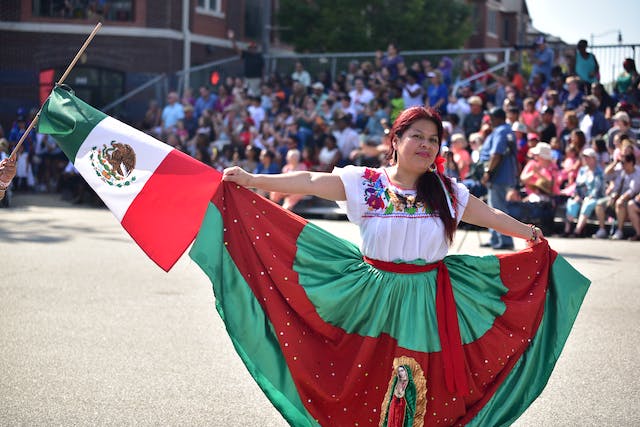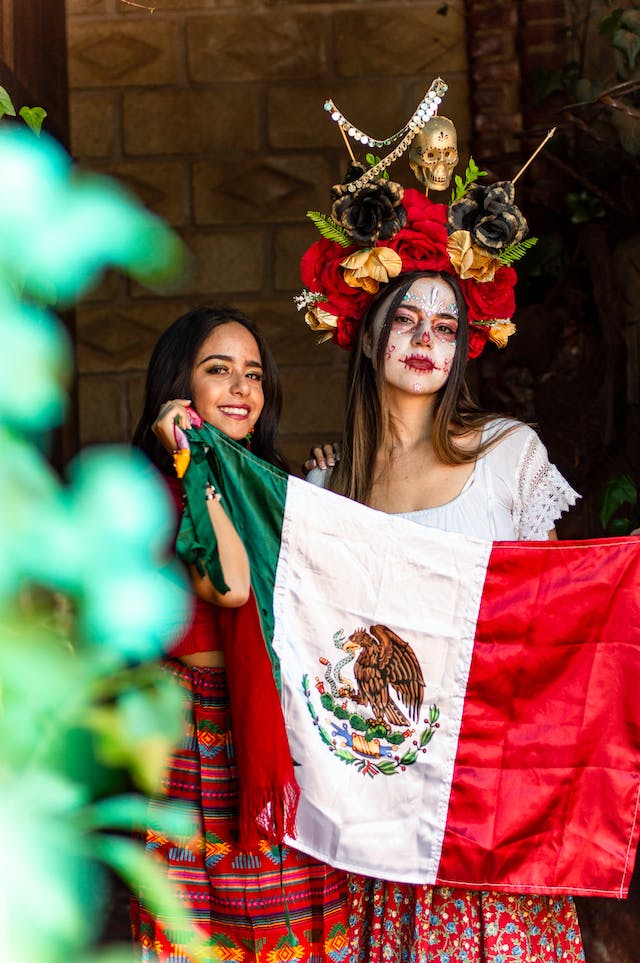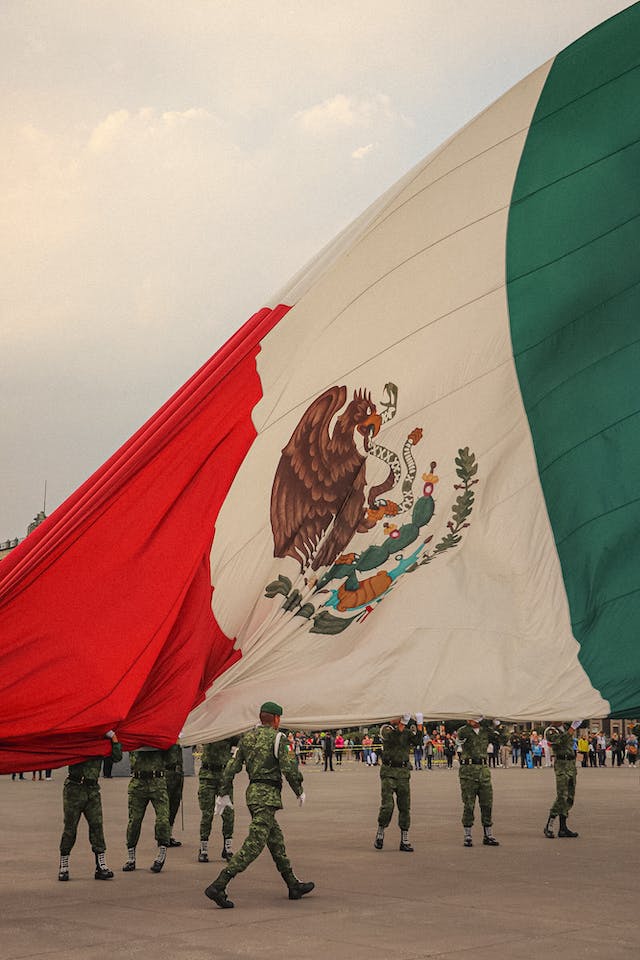Discover the rich symbolism and historical importance behind the Mexico flag, a vibrant emblem reflecting the nation’s identity. As a potent symbol of Mexican heritage, the flag embodies a deep sense of pride, unity, and cultural heritage. This exploration delves into the colors, symbols, and evolution of the Mexico flag, shedding light on its intricate design and the stories it carries. Join us on this illuminating journey through Mexico’s national pride, exploring the origins and meanings that make the flag a cherished emblem of the country’s past, present, and future. Explore the essence of Mexico’s identity woven into every thread and hue, as we unravel the captivating tale of the Mexico flag’s enduring legacy.”
Design Elements of the Mexico Flag: Colors and Symbols
When we dive into the vibrant tapestry of the Mexico flag’s design, exploring its rich colors and profound symbols we found the bold tricolor scheme of green, white, and red holds deep significance: green represents hope and fertility, white signifies purity and unity, while red symbolizes the blood shed by the nation’s heroes. Within its emblematic center, the Mexican coat of arms tells a tale of Aztec heritage, featuring an eagle perched on a cactus devouring a serpent. These elements echo ancient legends, embodying Mexico’s resilience and cultural roots. Unravel the layers of meaning behind each hue and motif, understanding how the Mexico flag weaves history, culture, and pride into its very fabric. Join us on this exploration of artistic ingenuity and national identity, as we delve into the heart of the Mexico flag’s design elements, shedding light on the enduring symbols that continue to unite the nation.”
Historical Evolution of the Mexico Flag
The history of the Mexico flag is a tale deeply intertwined with the nation’s struggle for independence and its rich cultural heritage. In the early 19th century, Mexico fought for freedom from Spanish colonial rule. The first national flag, adopted in 1821, featured vertical stripes of green, white, and red, symbolizing the lush Mexican landscape, purity, and the blood shed for independence, respectively.
However, as Mexico underwent political changes, so did its flag. The central emblem, depicting an eagle devouring a snake while perched on a cactus, originates from Aztec legend and signifies Mexico’s triumph over adversity. Over the years, the flag’s design underwent modifications, reflecting different political eras.
In 1968, the current version of the Mexico flag was established, maintaining the same colors and emblem. The green stands for hope and victory, the white for purity and unity, and the red for the blood of those who fought for Mexico’s independence. This flag stands as a powerful symbol of Mexico’s history, culture, and enduring spirit, embodying the nation’s resilience and pride.
The Coat of Arms: An In-depth Look at Mexico’s Emblem
At the heart of the Mexico flag lies a captivating emblem, rich in symbolism and history. The iconic coat of arms features an eagle perched atop a cactus, devouring a serpent—a powerful image rooted in Aztec legend. This emblem embodies Mexico’s resilience, depicting the triumph over adversity and tyranny.
The eagle, a revered bird in ancient Aztec culture, symbolizes power and courage. Its position on a cactus, situated on a rock amidst a lake, aligns with the prophecy guiding the Aztecs to their destined homeland—present-day Mexico City. The serpent, representing evil, is conquered by the eagle, illustrating the triumph of good over evil.
This emblem, adopted in 1968, showcases Mexico’s heritage, reflecting its indigenous roots and the spirit of its people. As a vital part of the Mexico flag, the coat of arms stands as a testament to the nation’s enduring history, unity, and cultural pride.”

Flag Etiquette: Rules and Customs Surrounding the Mexico Flag
Respecting the Mexico flag is a mark of honor and national pride. Understanding the flag etiquette is crucial to show proper reverence. When displayed, the flag must always be handled with care, kept clean, and never touch the ground. During ceremonies, it should be hoisted briskly and lowered ceremoniously.
Additionally, it’s important to avoid using the flag for decorative or commercial purposes that might tarnish its dignity. The flag should never be altered, defaced, or displayed upside down unless as a distress signal.
During national events, Mexicans gather to witness the ceremonial raising and lowering of the flag. This symbolizes unity and patriotism, fostering a sense of pride and community.
Following these customs surrounding the Mexico flag not only preserves its sanctity but also upholds the nation’s values. Showcasing respect for this revered symbol unites the country in a shared sense of identity and respect for its rich heritage.
The Mexico Flag in Popular Culture: Symbolism and Influence
The Mexico flag, with its vibrant tricolors and emblematic design, holds a significant place in popular culture. Its colors symbolize the country’s rich history, with green representing hope, white for unity, and red for the blood of national heroes.
In movies, TV shows, and artwork, the Mexico flag is often featured, representing themes of patriotism, resilience, and national identity. Its iconic eagle and serpent motif are frequently utilized, showcasing the nation’s heritage and cultural diversity.
The flag also inspires various products like clothing, accessories, and souvenirs, allowing people to display their pride and connection to Mexican heritage. During national celebrations, the flag is prominently displayed, emphasizing its role as a unifying symbol.
In music and literature, references to the Mexico flag evoke a sense of nostalgia and pride, celebrating the country’s cultural richness. Through these diverse mediums, the Mexico flag continues to shape and reflect the nation’s spirit, becoming a cherished icon in the hearts of many.”

The Mexico Flag as a Reflection of Mexican Identity: A Symbolic Journey
The Mexico flag stands tall as a powerful emblem, embodying the essence of Mexican identity and heritage. Its vibrant tricolors of green, white, and red tell a story of hope, unity, and bravery, reflecting the nation’s spirit.
Green represents the lush landscapes and agricultural wealth, signifying hope and prosperity. White signifies purity and unity, binding the diverse Mexican population into one harmonious entity. Red, the color of valor, embodies the sacrifices of national heroes and the people’s courage.
The flag’s iconic coat of arms, an eagle devouring a serpent while perched on a cactus, is deeply rooted in Aztec mythology, symbolizing the Mexica people’s ancient prophecy of a great empire. This emblem reflects Mexico’s rich indigenous heritage and resilience.
Displayed proudly during celebrations and events, the Mexico flag unites citizens, fostering a sense of belonging and national pride. It is a testament to Mexico’s historical struggles and triumphs, serving as a constant reminder of the nation’s enduring spirit and vibrant cultural mosaic.


